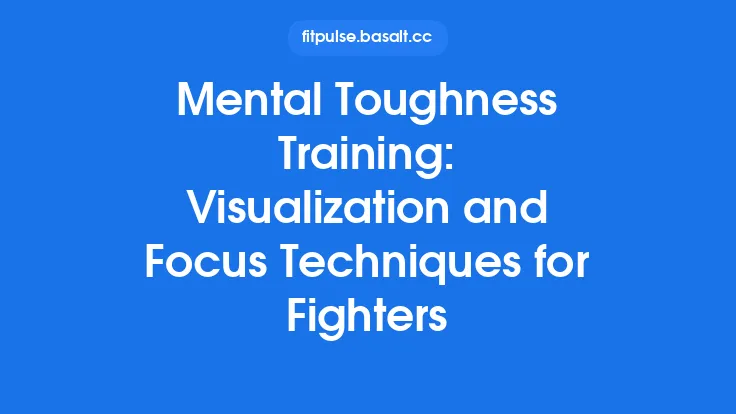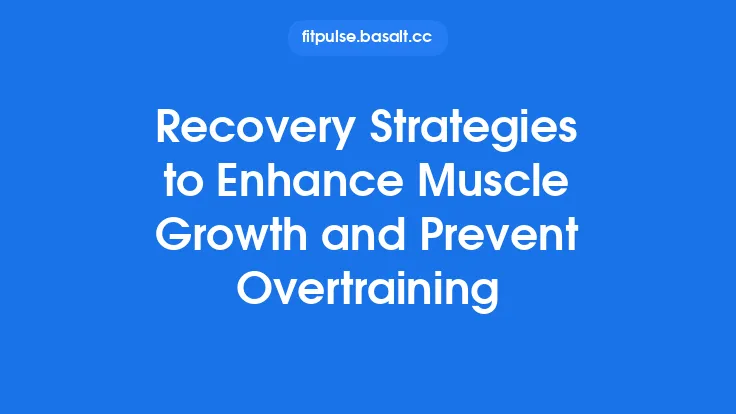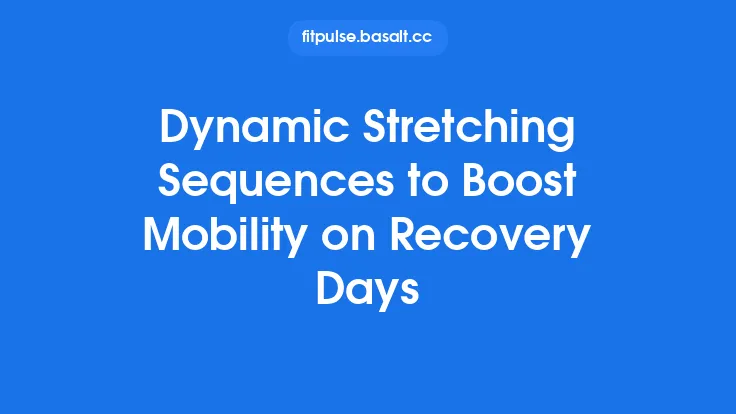Recovery isn’t just about what you do with your body; the mind plays an equally vital role in how quickly tissues heal, how well you can return to full performance, and how sharply you can stay focused during training. One of the most accessible, low‑cost tools for enhancing both physical recovery and mental concentration is visualization—the deliberate use of mental imagery to rehearse, reinforce, and accelerate the healing process. Below is a comprehensive guide that walks you through the science, the practical exercises, and the step‑by‑step integration of visualization into an athlete’s routine.
Why Visualization Works for Recovery and Focus
1. Neuromuscular Priming
When you picture a movement, the brain activates many of the same motor pathways that fire during the actual execution of that movement. Functional magnetic resonance imaging (fMRI) studies consistently show overlapping activation in the premotor cortex, supplementary motor area, and cerebellum during imagined and real actions. This “neural rehearsal” keeps the motor circuitry engaged, preventing the atrophy that can accompany prolonged rest.
2. Blood Flow Modulation
Imagery of a specific body part can trigger autonomic responses that modestly increase local blood flow. For example, visualizing a warm, throbbing sensation in a sore calf can stimulate vasodilation, delivering oxygen and nutrients that support tissue repair.
3. Pain Perception Adjustment
The brain’s pain matrix—comprising the anterior cingulate cortex, insula, and thalamus—responds not only to nociceptive input but also to expectations and attention. By visualizing a painless, smooth recovery, you can shift the brain’s interpretation of pain signals, reducing perceived discomfort and allowing you to engage more fully in rehab activities.
4. Cognitive Load Management
Focused imagery creates a mental “anchor” that limits wandering thoughts. This anchoring improves concentration during subsequent training sessions, helping you maintain technique and avoid compensatory movements that could lead to new injuries.
Foundations of Effective Visualization
1. Sensory Richness
The most potent visualizations engage all five senses:
- Sight: See the tissue healing, the muscle fibers knitting together.
- Touch: Feel warmth, a gentle stretch, or a light massage.
- Sound: Hear the rhythmic breathing, the subtle pop of a joint moving smoothly.
- Smell: Imagine the fresh scent of a clean training space or a calming essential oil.
- Proprioception: Sense the position and movement of the limb as if it were moving freely.
2. Temporal Perspective
Alternate between “process” visualizations (focusing on the step‑by‑step healing actions) and “outcome” visualizations (seeing yourself fully recovered and performing at peak level). Process imagery builds confidence in the journey, while outcome imagery fuels motivation.
3. Emotional Tone
Pair the visual scene with a positive emotional state—calm confidence, gratitude, or excitement. Emotions act as a catalyst, amplifying the neural pathways activated by the imagery.
4. Consistency and Duration
Research suggests that 10–15 minutes of focused visualization, performed 2–3 times per day, yields measurable benefits. Consistency is more important than occasional long sessions.
Core Visualization Exercises
Below are six structured exercises that can be woven into a daily recovery plan. Each exercise includes a brief rationale, a step‑by‑step script, and tips for maximizing effectiveness.
1. Healing Wave
Goal: Promote localized blood flow and reduce swelling.
Script:
- Sit or lie comfortably, close your eyes, and take three slow breaths.
- Direct your attention to the injured area (e.g., right knee). Imagine a warm, golden light gently washing over it.
- Visualize the light moving like a wave, starting at the skin surface, then slowly sinking deeper, reaching muscles, tendons, and finally the joint capsule.
- As the wave passes, picture any inflammation dissolving, like mist evaporating in the sun.
- Stay with the image for 2–3 minutes, feeling a subtle warmth and lightness.
Tips: Use a real-life reference—think of a sunrise over a calm sea—to make the wave feel natural. If you have access to a heating pad, you can briefly feel the warmth before visualizing, reinforcing the sensory link.
2. Muscle Fiber Re‑Weaving
Goal: Reinforce neuromuscular connections and prevent atrophy.
Script:
- Begin in a relaxed position, eyes closed, breathing evenly.
- Picture the specific muscle group (e.g., hamstrings) as a bundle of fine threads.
- See each thread being gently pulled, aligned, and interlaced with neighboring fibers, forming a stronger, more organized net.
- Imagine the fibers contracting and relaxing in perfect synchrony, as if you were performing a smooth, controlled stretch.
- Continue for 4–5 minutes, focusing on the sense of tension and release.
Tips: If you have a visual reference (e.g., a close‑up video of muscle fibers under a microscope), glance at it before the exercise to cement the mental image.
3. Joint Glide
Goal: Maintain joint range of motion and reduce stiffness.
Script:
- Sit with the target joint (e.g., shoulder) in a neutral position.
- Visualize the joint surfaces as two smooth, polished stones sliding over each other.
- See a thin film of lubricating fluid (synovial fluid) glistening between them, allowing a frictionless glide.
- Imagine moving the joint through its full, pain‑free range—up, down, inward, outward—while the stones glide effortlessly.
- Spend 3–4 minutes, paying attention to the sensation of smoothness.
Tips: Pair this with a gentle, actual passive range‑of‑motion movement if approved by a therapist; the physical cue can deepen the mental image.
4. Energy Recharge
Goal: Boost overall mental focus and reduce mental fatigue.
Script:
- Find a quiet spot, sit upright, and take five deep breaths.
- Visualize a bright, electric blue light at the crown of your head.
- See this light traveling down through your spine, filling each vertebra with a pulsing glow.
- As the light reaches the injured area, imagine it “charging” the tissue, infusing it with restorative energy.
- Allow the light to expand outward, enveloping your entire body, leaving you feeling alert and centered.
- Continue for 2 minutes, then open your eyes and note any shift in mental clarity.
Tips: Use a subtle background sound (e.g., a low hum) to reinforce the “energy” theme without introducing external distractions.
5. Performance Blueprint
Goal: Strengthen the mental link between recovery and future performance.
Script:
- After a short relaxation, picture yourself on the competition field or training arena, fully recovered.
- See the exact movement you aim to execute (e.g., a sprint start, a clean lift). Break it down into micro‑steps: foot placement, arm swing, breathing rhythm.
- In each micro‑step, notice the smoothness, the lack of pain, the confidence in your body.
- Replay the sequence several times, each time adding more vivid detail—crowd noise, the feel of the surface under your feet, the rhythm of your breath.
- End the visualization by feeling a surge of confidence and readiness.
Tips: Perform this exercise after a physical therapy session to cement the connection between rehab work and performance goals.
6. Recovery Countdown
Goal: Provide a structured mental timeline that reduces anxiety about healing duration.
Script:
- Sit comfortably, close your eyes, and imagine a calendar or timeline floating in front of you.
- Mark today’s date as “Day 0” and place a small, bright dot on the timeline.
- Visualize the next few weeks as a series of milestones (e.g., “Week 1 – reduced swelling,” “Week 2 – full range of motion,” “Week 3 – light functional drills”).
- See each milestone lighting up as you mentally “check it off,” accompanied by a sense of accomplishment.
- Spend 2–3 minutes reinforcing the belief that each step is achievable and progressing.
Tips: Keep a physical copy of the timeline in your training area; referencing it during visualization strengthens the mental‑physical link.
Integrating Visualization into a Daily Routine
| Time of Day | Suggested Exercise | Duration | Key Focus |
|---|---|---|---|
| Morning (after waking) | Energy Recharge | 2–3 min | Wake the nervous system, set a focused tone |
| Mid‑day (pre‑lunch) | Healing Wave or Muscle Fiber Re‑Weaving | 5–7 min | Reinforce recovery during a natural break |
| Afternoon (post‑training or therapy) | Joint Glide + Recovery Countdown | 5–8 min | Consolidate physical work, track progress |
| Evening (before bed) | Performance Blueprint | 5–10 min | Embed performance goals, promote restful sleep |
Practical Tips for Consistency
- Set a cue: Pair each visualization with an existing habit (e.g., after brushing teeth, after a therapy session).
- Use a timer: A gentle alarm signals the start and end, preventing the mind from wandering.
- Record sensations: A brief note in a log (e.g., “felt warmth in left shoulder”) helps track subtle changes over weeks.
- Adjust intensity: If a session feels forced, shorten it or simplify the imagery; the practice should remain enjoyable.
Common Pitfalls and How to Overcome Them
| Pitfall | Why It Happens | Solution |
|---|---|---|
| Mind wandering | The brain is accustomed to multitasking. | Use a “mental anchor” (e.g., a specific sound or breath) to bring attention back. |
| Over‑complicating the image | Trying to include too many details can cause confusion. | Start with a single sensory element, then gradually add layers. |
| Skepticism about effectiveness | Lack of immediate, tangible results. | Track objective markers (e.g., range of motion, pain scores) alongside subjective feelings; improvements often appear after several weeks. |
| Physical discomfort during visualization | Some injuries are painful even when imagined. | Begin with a neutral, pain‑free body part and gradually shift focus to the injured area as tolerance builds. |
| Inconsistent practice | Busy schedules lead to missed sessions. | Schedule visualizations as “appointments” in a calendar and treat them like any other training session. |
Measuring Progress
While visualization is inherently internal, you can still gauge its impact through a combination of subjective and objective metrics:
- Pain Rating Scale (0–10): Record before and after each week’s visualization block.
- Range of Motion (goniometer or smartphone app): Measure joint angles at baseline and after 2–4 weeks.
- Functional Tests: Simple tasks like a single‑leg balance or a light hop can indicate neuromuscular readiness.
- Focus Assessment: Use a brief concentration test (e.g., a 2‑minute Stroop task) before and after a visualization session to see if mental clarity improves.
- Recovery Log: Note any changes in sleep quality, perceived fatigue, or mood.
Consistent improvement across these markers often correlates with a well‑structured visualization practice.
Frequently Asked Questions
Q: Do I need any special equipment?
A: No. A quiet space, a comfortable seat or mat, and optionally a timer or soft background music are sufficient.
Q: Can visualization replace physical therapy?
A: No. It is a complementary tool that enhances the effects of physical interventions, not a substitute.
Q: How long before I notice benefits?
A: Most athletes report subtle shifts in pain perception and focus within 1–2 weeks, with more pronounced recovery gains after 4–6 weeks of regular practice.
Q: Is it okay to visualize while injured?
A: Absolutely. The mental rehearsal is safe and can even reduce the fear of movement that sometimes accompanies injury.
Q: What if I’m not “good at visualizing”?
A: Visualization is a skill that improves with practice. Begin with simple images (e.g., a ball rolling) and gradually build complexity.
Final Thoughts
Visualization bridges the gap between mind and body, turning recovery from a passive waiting period into an active, purposeful process. By deliberately engaging the brain’s motor and sensory networks, you can:
- Maintain neural pathways during periods of reduced physical activity.
- Modulate blood flow and pain perception to create a more favorable healing environment.
- Sharpen concentration for subsequent training sessions, reducing the risk of compensatory injuries.
The exercises outlined above are designed to be adaptable, evidence‑informed, and easy to embed into any athlete’s daily schedule. Start with a few minutes each day, stay consistent, and watch how the mental rehearsal of recovery translates into faster, more focused returns to full performance.





